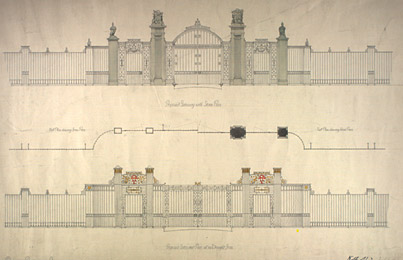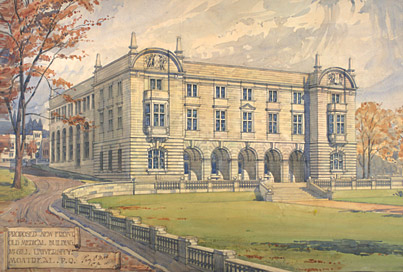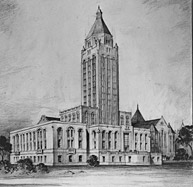The campus that never was (Page 2)
The campus that never was (Page 2) McGill University
User Tools (skip):
The campus that never was (Page 2)
The gate and fence

Percy Nobbs recognized that McGill's most distinguishing visual feature was the graceful avenue leading from the steps of the Arts Building to the Sherbrooke Street entrance. The challenge was how to use the ample space along the front of the campus while still preserving this view.
One idea Nobbs described in his 1922 plan (before the Roddick Gates were constructed) would have made an enclosed compound of the campus: "[On] the Sherbrooke Street frontage we find there a magnificent site for a long three- or at most four-storey building extending from the old Workman property at the University Street corner to the old Joseph property at the McTavish Street corner. This block should be pierced with a towered gateway leading to the main avenue."
An approach that would have left the face of campus somewhat more open to the city -- yet still visually separated from it -- would have seen a tall wrought iron fence stretch along the length of Sherbrooke, with ornate gates on the main avenue.
"This plan is rather flat -- there is some indentation, but the Roddick Gates sweep back," notes Drummond. "It obviously influenced the design of the Roddick Gates."
Drummond points out that fencing in public areas was a common practice at different points over the last century. In fact, it used to be tradition that the Roddick Gates were opened only for visits by royalty or the Governor General.
Strathcona Medical Building

Before the current Strathcona Anatomy and Dentistry Building was constructed, Nobbs suggested that the site of the original medical building, which burned down in 1907, could serve as the foundation for its replacement. Instead, the Biology Building was constructed on that location, which has become the James Administration Building (a frog over the main door attests to the James's original vocation).
Drummond said he likes the design, but questions its size.
"It's too large for the site," he says, pointing out that it would have cut off the area of campus above it. This would have mattered less at the time, as McGill didn't own much of the property and houses along University Avenue where the new Trottier Building and other structures now stand.
"McGill bought those houses, sold them and bought them again a few times," says Drummond.
Redpath Library
In the 1920s the shortage of stack space in the Redpath Library was becoming acute. McGill's collections were embarrassingly sparse, and the University acquisitions were not keeping pace with any comparable institution in North America.

By 1921 it was decided to expand the building. Nobbs's design was the one eventually used, which, in Nobbs biographer Susan Wagg's view, "created a fitting conclusion -- both visually and stylistically -- to the architectural sequence that unfolded along McTavish Street."
An architect by the name of Colin Drewitt also put forward a bold proposal to add even further to the library. His vision would have added a structure that would jut out into the Lower Field to the immediate south of the existing structure. Its centrepiece would have been an eight-storey tower.
Drummond points out that Drewitt's tower was without any context anywhere else at McGill or the surrounding area. McGill's western campus buildings have a low profile for a reason, explains Drummond.
"The tower would have cast a shadow over campus, and totally dwarfed the Redpath. It would have been completely out of keeping with the houses and other buildings on McTavish." The rest of the proposed structure is little better: "It looks very heavy and doesn't blend well with Redpath Hall."


